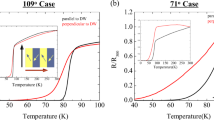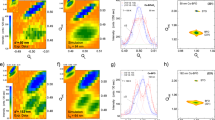Abstract
Many interesting materials phenomena such as the emergence of high-Tc superconductivity in the cuprates and colossal magnetoresistance in the manganites arise out of a doping-driven competition between energetically similar ground states. Doped multiferroics present a tantalizing evolution of this generic concept of phase competition. Here, we present the observation of an electronic conductor–insulator transition by control of band-filling in the model antiferromagnetic ferroelectric BiFeO3 through Ca doping. Application of electric field enables us to control and manipulate this electronic transition to the extent that a p–n junction can be created, erased and inverted in this material. A ‘dome-like’ feature in the doping dependence of the ferroelectric transition is observed around a Ca concentration of ∼1/8, where a new pseudo-tetragonal phase appears and the electric modulation of conduction is optimized. Possible mechanisms for the observed effects are discussed on the basis of the interplay of ionic and electronic conduction. This observation opens the door to merging magnetoelectrics and magnetoelectronics at room temperature by combining electronic conduction with electric and magnetic degrees of freedom already present in the multiferroic BiFeO3.
This is a preview of subscription content, access via your institution
Access options
Subscribe to this journal
Receive 12 print issues and online access
$259.00 per year
only $21.58 per issue
Buy this article
- Purchase on Springer Link
- Instant access to full article PDF
Prices may be subject to local taxes which are calculated during checkout






Similar content being viewed by others
References
Imada, M., Fujimori, A. & Tokura, Y. Metal–insulator transitions. Rev. Mod. Phys. 70, 1039–1263 (1998).
Jin, S. et al. Thousandfold change in resistivity in magnetoresistive La–Ca–Mn–O films. Science 264, 413–415 (1994).
Uehara, M., Mori, S., Chen, C. H. & Cheong, S. W. Percolative phase separation underlies colossal magnetoresistance in mixed-valent manganites. Nature 399, 560–563 (1999).
Verwey, E. J. W. Electronic conduction of magnetite (Fe3O4) and its transition point at low temperatures. Nature 144, 327–328 (1939).
Liu, Y., Haviland, D. B., Nease, B. & Goldman, A. M. Insulator-to-superconductor transition in ultrathin films. Phys. Rev. B 47, 5931–5946 (1993).
Ren, X. Large electric-field-induced strain in ferroelectric crystals by point-defect-mediated reversible domain switching. Nature Mater. 3, 91–94 (2004).
Agrawal, R. C. & Gupta, R. K. Superionic solids: Composite electrolyte phase—an overview. J. Mater. Sci. 34, 1131–1162 (1999).
Hemberger, J. et al. Quantum paraelectric and induced ferroelectric states in SrTiO3 . J. Phys. Condens. Matter 8, 4673–4690 (1996).
Xu, G., Zhong, Z., Bing, Y., Ye, Z.-G. & Shirane, G. Electric-field-induced redistribution of polar nano-regions in a relaxor ferroelectric. Naure Mater. 5, 134–140 (2006).
Meijer, G. I. et al. Valence states of Cr and the insulator-to-metal transition in Cr-doped SrTiO3 . Phys. Rev. B 72, 155102 (2005).
Ahn, C. H., Triscone, J.-M. & Mannhart, J. Electric field effect in correlated oxide systems. Nature 424, 1015–1018 (2003).
Ahn, C. H. et al. Electricstatic modification of novel materials. Rev. Mod. Phys. 78, 1185–1212 (2006).
Yamamura, H. & Kiriyama, R. Oxygen vacancies in the perovskite-type ferrites. I. Relation between oxygen vacancies and structures in the solid solution systems Sr1−xMxFeO3−δ (M=yittrium, lanthanum, bismuth, and indium). Nippon Kagaku Kaishi 2, 343–349 (1972).
Fiebig, M. Revival of the magnetoelectric effect. J. Phys. D 38, R123–R152 (2005).
Ramesh, R. & Spaldin, N. A. Multiferroics: Progress and prospects in thin films. Nature Mater. 6, 21–29 (2007).
Cheong, S. W. & Mostovoy, M. Multiferroics: A magnetic twist for ferroelectricity. Nature Mater. 6, 13–20 (2007).
Roginska, Y. E., Tomashpo, Y. Y., Venevtse, Y. N., Petrov, V. M. & Zhdanov, G. S. Nature of dielectric and magnetic properties of BiFeO3 . Sov. Phys. JETP 23, 47–51 (1966).
Kiselev, S. V., Ozerov, R. P. & Zhdanov, G. S. Detection of magnetic order in ferroelectric BiFeO3 by neutron diffraction. Sov. Phys. Dokl. 7, 742–744 (1963).
Chu, Y. H. et al. Domain control in multiferroic BiFeO3 through substrate vicinality. Adv. Mater. 19, 2662–2666 (2007).
Gavriliuk, A. G. et al. Another mechanism for the insulator–metal transition observed in Mott insulators. Phys. Rev. B 77, 155112 (2008).
Seidel, J. et al. Conduction at domain walls in oxide multiferroics. Nature Mater. 8, 229–234 (2009).
Palai, R. et al. β phase and γ–β metal–insulator transition in multiferroic BiFeO3 . Phys. Rev. B 77, 014110 (2008).
Brinkman, K., Iijima, T. & Takamura, H. Acceptor doped BiFeO3 ceramics: A new material for oxygen permeation membranes. Japan. J. Appl. Phys. 2 46, L93–L96 (2007).
Khomchenko, V. A. et al. Synthesis and multiferroic properties of Bi0.8A0.2FeO3 (A=Ca, Sr, Pb) ceramics. Appl. Phys. Lett. 90, 242901 (2007).
Li, J., Duan, Y., He, H. & Song, D. Crystal structure, electronic structure, and magnetic properties of bismuth-strontium ferrites. J. Alloys Compounds 315, 259–264 (2001).
Pertsev, N. A., Zembilgotov, A. G. & Tagantsev, A. K. Effect of mechanical boundary conditions on phase diagrams of epitaxial ferroelectric thin films. Phys. Rev. Lett. 80, 1988–1991 (1998).
Schlom, D. G. et al. Strain tuning of ferroelectric thin films. Annu. Rev. Mater. Res. 37, 589–626 (2007).
Ederer, C. & Spaldin, N. A. Effect of epitaxial strain on the spontaneous polarization of thin film ferroelectrics. Phys. Rev. Lett. 95, 257601 (2005).
Klie, R. F. & Browning, N. D. Characterization of oxygen ordering in (La,Sr)FeO3−δ by atomic resolution Z-contrast imaging and electron energy-loss spectroscopy. J. Electron Microscopy 51, S59–S66 (2002).
Becerro, A. I. et al. The transition from short-range to long-range ordering of oxygen vacancies in CaFexTi1−xO3−x/2 perovskites. Phys. Chem. Chem. Phys. 2, 3933–3941 (2000).
Grenier, J.-C., Pouchard, M. & Hagenmuller, P. Vacancy ordering in oxygen-deficient perovskite-related ferrites. Struct. Bond. 47, 1–25 (1981).
Vashook, V. V., Daroukh, M. A. & Ullmann, H. Oxygen ion diffusion in perovskite-type oxides determined by permeation and by relaxation measurements. Ionics 7, 59–66 (2001).
Mogilevsky, R. et al. Direct measurements of room-temperature oxygen diffusion in YBa2Cu3Ox . Phys. Rev. B 49, 6420–6423 (1994).
Merkle, R. & Maier, J. How is oxygen incorporated into oxides? A comprehensive kinetic study of a simple solid-state reaction with SrTiO3 as a model material. Angew. Chem. Int. Ed. 47, 3874–3894 (2008).
Zavaliche, F. et al. Ferroelectric domain structure in epitaxial BiFeO3 films. Appl. Phys. Lett. 87, 182912 (2005).
Uchida, K., Tsuneyuki, S. & Schimizu, T. First principles calculations of carrier-doping effects in SrTiO3 . Phys. Rev. B 68, 174107 (2003).
Blom, P. W. M., Wolf, R. M., Cillessen, J. F. M. & Krijn, M. P. C. M. Ferroelectric Schottky diode. Phys. Rev. Lett. 73, 2107–2110 (1994).
Bunget, I. & Popescu, M. Physics of Solid Dielectrics (Elsevier, 1984).
Szot, K., Speier, W., Bihlmayer, G. & Waser, R. Switching the electric resistance of individual dislocations in single-crystal SrTiO3 . Nature Mater. 5, 312–320 (2006).
Clayton, J. D., Chung, P. W., Grinfeld, M. A. & Nothwang, W. D. Continuum modeling of charged vacancy migration in elastic dielectric solids, with application to perovskite thin films. Mech. Res. Commun. 35, 57–64 (2008).
Mott, N. F. Metal–insulator transition. Rev. Mod. Phys. 40, 677–683 (1968).
Tsuda, N., Nasu, K., Yanase, A. & Siratori, K. Electronic Conduction in Oxides (Springer, 2000).
Lim, S.-H. et al. Enhanced dielectric properties in single crystal-like BiFeO3 thin films grown by flux-mediated epitaxy. Appl. Phys. Lett. 92, 012918 (2008).
Hauser, A. J. et al. Characterization of electronic structure and defect states of thin epitaxial BiFeO3 films by UV–visible absorption and cathodoluminescence spectroscopies. Appl. Phys. Lett. 92, 222901 (2008).
Takada, Y. & Masaki, M. Polarons in Jahn-Teller crystals: Intrinsic difference between eg and t2g electrons. J. Supercond. Nov. Magn. 20, 629–633 (2007).
Acknowledgements
The work is supported by the Director, Office of Science, Office of Basic Energy Sciences, Materials Sciences Division of the US Department of Energy under contract No. DE-AC02-05CH11231. C.-H.Y. would like to acknowledge the Korea Research Foundation Grant funded by the Korean Government (MOEHRD). (KRF-2006-214-C00020) J.S. acknowledges support from the Alexander von Humboldt Foundation. Y.H.C. would like to acknowledge the support of the National Science Council, R.O.C., under Contract No NSC 97-3114-M-009-001. A portion of this research was carried out as a user project at Oak Ridge National Laboratory’s Center for Nanophase Materials Sciences, sponsored by the Scientific User Facilities Division, BES, US DOE.
Author information
Authors and Affiliations
Corresponding author
Supplementary information
Supplementary Information
Supplementary Information (PDF 1144 kb)
Rights and permissions
About this article
Cite this article
Yang, CH., Seidel, J., Kim, S. et al. Electric modulation of conduction in multiferroic Ca-doped BiFeO3 films. Nature Mater 8, 485–493 (2009). https://doi.org/10.1038/nmat2432
Received:
Accepted:
Published:
Issue Date:
DOI: https://doi.org/10.1038/nmat2432
This article is cited by
-
Effect of oxygen vacancies injection on the resistance switching properties of Hf0.5Zr0.5O2
Journal of Sol-Gel Science and Technology (2024)
-
Influence of (Sr, Zr) Ion Co-doping on the Enhanced Magnetic and Dielectric Response of BiFeO3
Journal of Electronic Materials (2024)
-
Multiferroic and energy-storage characteristics of polycrystalline Ca-doped BiFeO3 thin films on Si substrates
Journal of the Korean Ceramic Society (2023)
-
Light-Tunable Resistive Switching Properties of a BiFeO3/Ti3C2 Heterostructure Memristor
Journal of Electronic Materials (2023)
-
Critical ionic transport across an oxygen-vacancy ordering transition
Nature Communications (2022)



